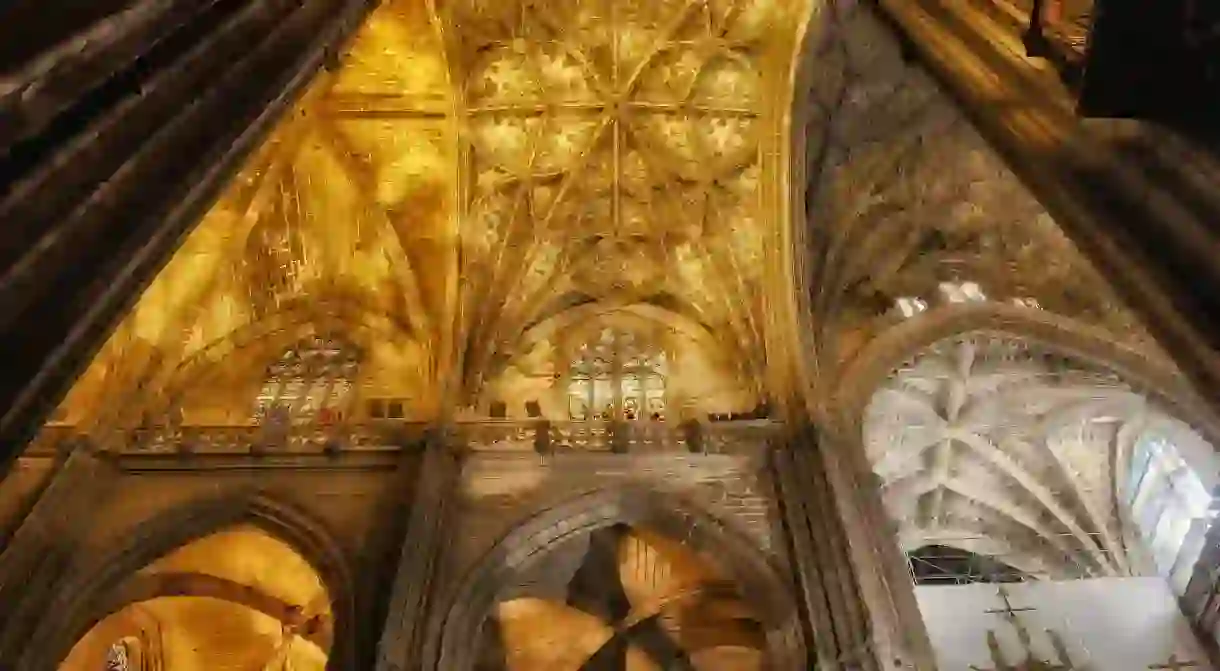The Most Impressive Buildings in Seville, Spain

The southern city of Seville is home to some of southern Spain’s most impressive historical monuments. From the Royal Alcázar Palace – the finest example of Mudéjar architecture in Spain – to a beautiful old townhouse said to have inspired the balcony scene in Shakespeare’s Romeo and Juliet, here are the buildings you don’t want to miss when visiting the Andalusian capital.
Seville Cathedral
Cathedral, Mosque

Seville’s mighty cathedral squats at the heart of the city’s historic centre and impresses with its size: it is the largest Gothic cathedral and the third largest church in the world. As in many other cities in Andalusia, its construction was partly motivated by a desire on the part of the conquering 14th-century Catholic monarchs to vanquish memories of their Moorish predecessors. Seville Cathedral was begun in 1401 on the site of what used to be the city’s mosque. Work continued for over 100 years, and in 1507 the cathedral was finally completed, succeeding quite spectacularly in fulfilling the design team’s original aim of making something beautiful and magnificent. Its iconic Giralda bell tower was formerly the mosque’s minaret, and is all that remains of the structure that preceded the cathedral.
Royal Alcázar Palace
Building, Cathedral, Historical Landmark

Along with the cathedral, Seville’s key architectural attraction is the Royal Alcázar Palace, considered by many to be one of the finest examples of Mudéjar architecture (the name given to a blend of Moorish and Renaissance styles) in Spain. Work on this great palace complex began in the 10th century, when the Umayyads built a Moorish fortress attached to the Roman city walls, but it was not until the 12th century that the first royal palace was built on the site, by the then-ruling Almohad Dynasty. Additions and renovations continued on and off until the 19th century, resulting in a structure that showcases a mix of Moorish, Renaissance and Mudéjar architecture, with the latter style being particularly notable in the Mudéjar Palace. The upper floors of the Alcázar comprise the Spanish royal family’s Seville residence, making it the oldest continually used royal palace in Europe.
The Bullring
Building, Museum, Sports Center

Though there are officially seven bullrings in Spain with First Category status, two share the top spot: Madrid’s Las Ventas and Seville’s Real Maestranza. Seville’s is one of the most attractive plazas in Spain, and even if you don’t wish to experience the bullfighting that occurs on its bright sands, it is well worth a visit in its own right. Tours are available and there’s a museum inside. Construction began in 1761 on the site of the city’s old rectangular plaza de toros, and was finally completed in 1881; particularly attractive is the iconic Prince’s Gate (the main entrance), the ornate black iron gates of which are the work of Pedro Roldan, and which were originally the property of a convent. Being carried through these on the shoulders of fellow matadors and the public is a mark of great triumph, and one of the highest honours attainable by a matador in Spain.
Casa de Pilatos
Building

This beautiful 15th-16th century mansion is one of central Seville’s hidden treasures, and its exquisite gardens, though smaller in scale, match anything you’ll see in the Alcázar. Begun by the wealthy conquistador and Mayor of Andalucia, Pedro Enriquez de Quiñones, in the late 1400s, Casa de Pilatos is another of Seville’s classic Mudéjar structures, built around a central courtyard in the traditional Andalusian style. Its name – Pilate’s House – was bestowed (hopefully with a touch of gentle mockery) after Quiñones’ son Fadrique traveled to Jerusalem in 1519 and returned overflowing with enthusiasm for the Holy Land. The palace’s undeniable good looks have earned it a starring role in two films: 1962’s Lawrence of Arabia and 2010’s Knight and Day.
Plaza de España
Building, Memorial

Another of Seville’s Mudejar classics is the Plaza de España, a stunning development built in 1928 in preparation for Seville’s hosting of the Ibero-American Exposition of 1929. The half-moon building is fronted by a moat and borders on a plaza with a beautiful fountain at its centre; it showcases a striking mix of Mudéjar and Renaissance styles, with splashes of Art Deco also to be seen on the colourful façades. Boating can be enjoyed on the moat, spanned by four bridges representing the ancient kingdoms of Spain, so you can paddle around, admiring this impressive structure from your vessel.
'Romeo and Juliet' Building
Building
Winding along beside the Alcázar is a narrow, shaded alleyway called Calle Agua, named after a mini-aqueduct that used to run along the top of the Moorish palace’s walls. This mysterious path brings you out onto the absurdly romantic Plaza Alfaro, likely to be busy with tourists pointing their cameras upwards and snapping away at the building that is said to have inspired the balcony scene in Shakespeare’s Romeo and Juliet. Whether this tale is apocryphal or not, it’s easy to imagine Romeo scaling this, one of Seville’s prettiest buildings, to reach the object of his desire.
Archivo de Indias
Building

Documenting the Golden Age of the Spanish Empire that followed Christopher Columbus’s ‘discovery’ of the Americas in 1492 is Seville’s grand Archive of the Indies. These impressive 16th-century buildings, which form part of the UNESCO-protected area that also includes the cathedral and Alcázar, sit right next door to the cathedral and house some 80 million documents relating to the Spanish Empire of the 16th, 17th and 18th centuries. If you think that sounds like a little too much reading for one afternoon, fear not: as well as the beautiful old books and the palatial buildings themselves, other sights here include a 17th-century cannon, maps charting the entire Spanish Empire and several paintings by Goya.













